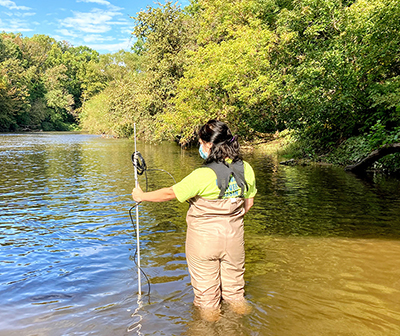Delaware • New Jersey • Pennsylvania
New York • United States of America
- Aquatic Life Designated Use Study
- Bacteria Monitoring
- Biomonitoring Program
- Chlorides Monitoring
- Contaminants of Emerging Concern
- Delaware Estuary Water Quality Monitoring Program
- Dissolved Oxygen and Nutrients
- Modeling
- Other Monitoring Programs & Studies (e.g., Fish Tissue, Microplastics, Metals)
- PCBs and PMPs
- Special Protection Waters (SPW)
- Water Resource Data Sets
 |
| DRBC staff take a flow measurement. Photo by DRBC. |
Ambient Toxicity Monitoring
As part of ongoing programs to control toxic substances in the Delaware Estuary, the DRBC conducts periodic monitoring of ambient water toxicity in the estuary and has requested monitoring of acute and chronic effluent toxicity by dischargers.
• Learn more about Ambient Toxicity Monitoring
Cyanotoxin Study
In 2022, the DRBC initiated a study to look at the presence/absence of harmful algal blooms (HABs) toxins (anatoxin, microcystins and cylindrospermopsin) at 11 sites in the mainstem tidal Delaware River.
As drinking water intakes are situated along the Delaware River, it is important to understand if, and where, algal toxins are detected from a human health standpoint.
• During August and September, 2022, DRBC staff deployed SPATT (Solid Phase Adsorption Toxins Tracking) bags, collecting after eight days; a total of three rounds of this was completed.
• The Del. Dept. of Natural Resources and Environmental Control (DNREC) lab handled analysis.
• Results indicated the presence of microcystin at all sites and anatoxin-a at most sites.
In 2023, the DRBC repeated the SPATT methodology at 15 sites in the mainstem non-tidal Delaware River to test for presence of cyanotoxins. As in 2022, the deployment period totaled 8-days; sampling occurred in August and September. DNREC will again handle sample analysis. Results showed the presence of microcystin in the non-tidal sites sampled.
In 2024, monitoring will continue with targeted sampling at ten sites, both tidal and non-tidal locations. The same sampling protocol will be followed as in previous years: 8-day deployments, sampling in August & September and DNREC will handle sample analysis. In addition, this year staff will collect surface water samples during deployment and retrieval of SPATT bags at each location for concurrent microcystin congener analysis.
Fish Tissue Monitoring
Since 1990, DRBC has periodically sampled tissues of resident fish species in the non-tidal and tidal portions of the main stem Delaware River.
Data collected by DRBC help inform Fish Consumption Advisories issued by certain Basin states.
• Learn more about Fish Tissue Monitoring
• Learn more about Fish Consumption Advisories
Microplastics
DRBC received a grant to study microplastics in the Delaware River Estuary in 2018. Samples were collected in 2019, 2020 and 2021, with cleanups held at two hot spots in the fall of 2021. A final report was published in August 2022.
• Learn more about Microplastics & view the Study's Final Report
Monitoring for Metals
DRBC monitors metals, such as copper, aluminum, zinc, nickel, and mercury, in ambient water, sediment, and tissues of aquatic life of the Delaware Estuary to ensure compliance with water quality criteria.
• Learn more about Metals Monitoring
Phytoplankton Study
DRBC's eutrophication model suggests that observed phytoplankton blooms in Zones 3-5 may be caused by transient micro-blooms in Zone 2 that propagate and magnify downstream in the estuary. This monitoring effort will obtain additional field data to help explain observed phytoplankton blooms on finer geographic and temporal scales than existing monitoring regimes provide.
• In 2024, DRBC will install continuous fluorometers at three locations: Schuylkill River at Fairmount Dam; Delaware River at Bristol Wharf; and Delaware River at Chester (Kimberly-Clark gage).
• The meters will be deployed from mid-April to mid-October.
• In addition, chlorophyll-a and algal samples will be collected to identify density and composition. All analytical work to be conducted by the Academy of Natural Sciences Drexel University.
Sediment Sampling
DRBC samples sediment to monitor for PCBs, as well as for chlorinated pesticides, PFAS, metals and dioxin/furans.
• Learn more about Sediment Sampling
Sturgeon Spawning DO Study
In June - September 2022, the DRBC initiated a study of dissolved oxygen (DO) trends in areas considered nursery grounds for juvenile endangered Atlantic sturgeon. Low flows are targeted.
• Four to six DO loggers were deployed at Chester, Pa., Marcus Hook and Fox Point Park. DO levels at the top and bottom were sampled.
• This data complements the DO data currently being collected at the Ben Franklin Bridge.
This study was performed in 2023 from July to September and will be again in 2024. DO loggers will be deployed at three locations near Marcus Hook; top and bottom will again be sampled, targeting low flows from June-September.
Thermal Plume Monitoring in Upper Delaware
In the summer 2024, using a drone equipped with a thermal imaging camera, DRBC staff will perform thermal plume surveillance in the upper Delaware River at five locations.
These targeted areas support cold water fisheries. Understanding if undocumented thermal plumes are occurring is important, as warmer waters impact cold water fish species.
Upper Delaware Low Flow Habitat Study
This study is to collect data to support modeling efforts to better understand how low flows affect habitat.
During times of low flows, staff will measure flow and depth at various locations in the upper Delaware River.
Copyright © Delaware River Basin Commission,
P.O. Box 7360, West Trenton, NJ 08628-0360
Phone (609)883-9500; Fax (609)883-9522
Thanks to NJ for hosting the DRBC website